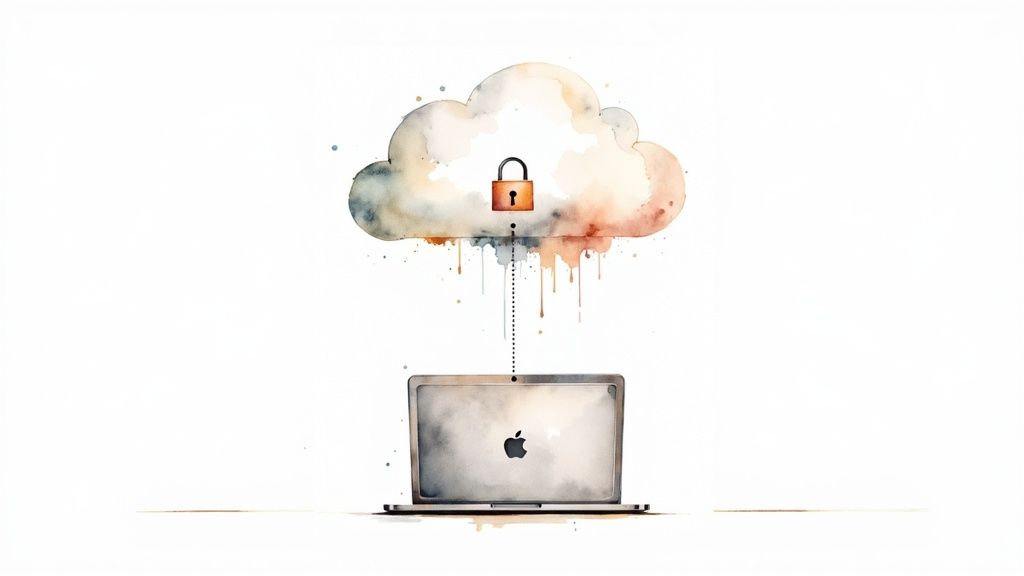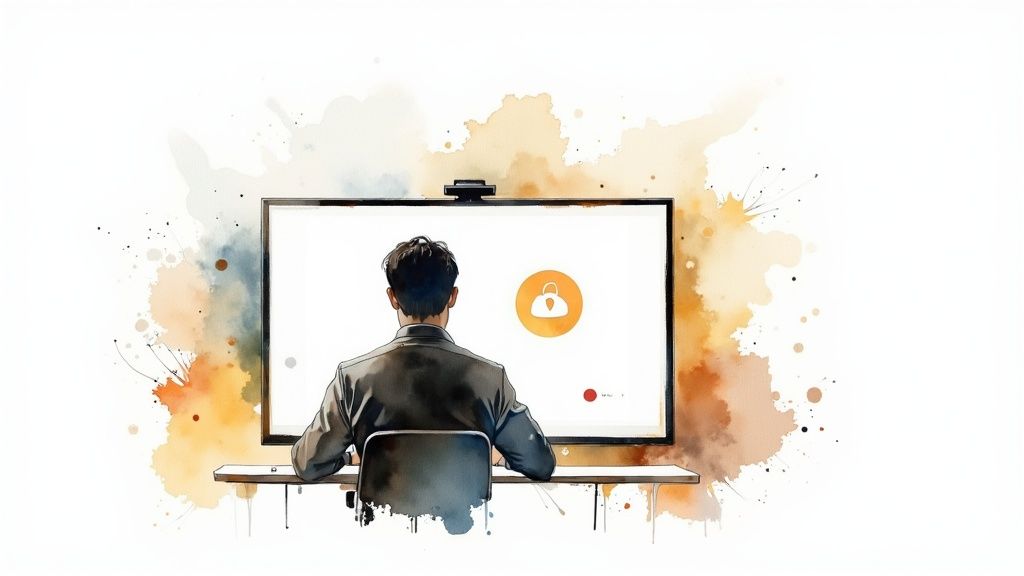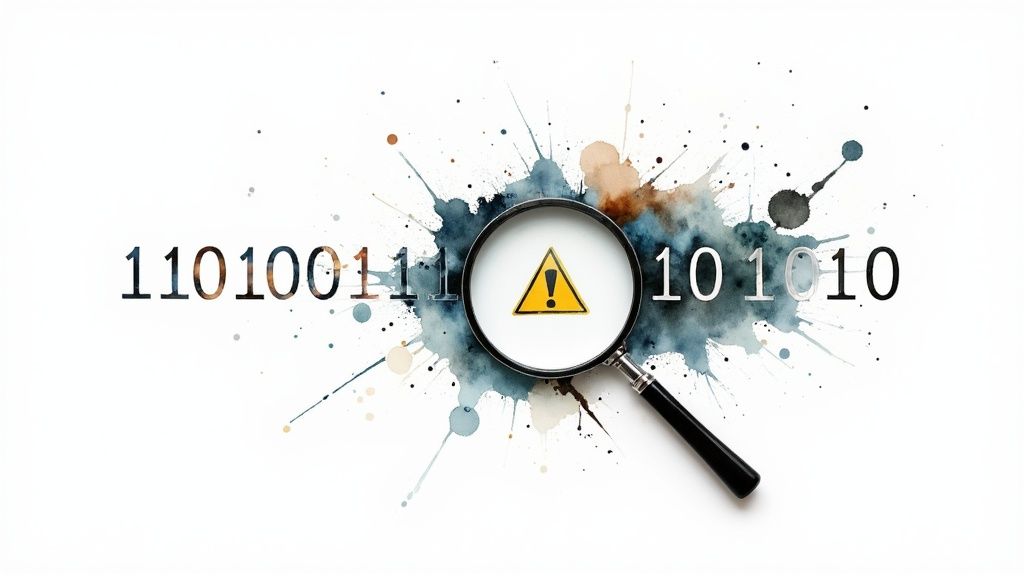In the old days, cybersecurity was a bit like protecting a medieval castle. You had thick walls, a single drawbridge, and a big moat—your corporate firewall. Everything important was inside, and everything dangerous was outside. Simple.
But that model is completely broken. Today, the office isn’t one central castle; it’s a sprawling kingdom of hundreds of individual homes, each with its own potential entry point. This is the new reality of remote cybersecurity: defending an organization’s data, networks, and people, no matter where they log in from. It’s a fundamental shift from guarding a building to securing countless endpoints spread across the map.
Securing the New Digital Workplace

Welcome to the new frontier of work. The old security playbooks are obsolete because the very definition of the “workplace” has changed. We’ve traded a single, controllable environment for a decentralized, unpredictable one.
Think about it. Each employee’s home office is its own mini-fortress, complete with unique vulnerabilities. Unsecured Wi-Fi, personal devices accessing sensitive files, and the physical security of a spare bedroom are all now part of the corporate defense landscape.
An Expanded Digital Battlefield
This massive distribution of the workforce has dangerously expanded the attack surface—the total number of spots an attacker can use to get in or steal data. Every laptop, every home network, every smartphone is now a potential front door for cyber threats. A proactive remote cybersecurity strategy isn’t just a good idea anymore; it’s a core business necessity.
The challenges we’re facing are a mix of technology and human behavior. Organizations are now wrestling with:
- Unsecured Home Networks: Your office Wi-Fi is locked down, but what about an employee’s consumer-grade router that hasn’t had a firmware update in two years? It’s a prime target.
- Personal Device Usage (BYOD): When work emails and company files live on the same phone as games and social media apps, the risk of malware crossover is huge.
- Increased Phishing Risks: It’s much harder for a remote employee to lean over and ask a coworker, “Hey, does this email look weird to you?” This isolation makes them more vulnerable to clever phishing scams.
The perimeter is no longer a clear line drawn around an office building. It’s a fluid, ever-changing boundary that wraps around every single employee’s location, demanding a much more dynamic and vigilant defense.
Getting a handle on this new environment starts with creating clear, understandable rules. Using a comprehensive guide to build a work-from-home policy is a fantastic first step. You can find a solid one here: https://remotefirstjobs.com/blog/work-from-home-policy-template.
From there, you need to implement practical safeguards. Adopting these essential remote work security best practices is the next logical move. Taking these proactive steps is how you build a resilient and secure team, ensuring your digital assets stay protected no matter where work gets done.
The Undeniable Risks of Remote Work
When a company shifts to a remote workforce, it’s like trading a single, fortified bank vault for thousands of individual safety deposit boxes scattered across the country. Sure, it’s more flexible, but this distribution creates a complex web of security risks that simply didn’t exist when everyone was under one roof. The potential for a breach multiplies with every new remote connection.
Understanding these threats is the first step toward building a real defense. The financial and reputational fallout from a single successful attack can be devastating. Investing in remote cyber security isn’t just an IT expense; it’s a fundamental part of keeping the business running and maintaining customer trust in a world where the office has no walls.
The Human Element Under Pressure
Cybercriminals are masters of psychology. They know remote employees can feel disconnected, making them prime targets for social engineering tactics like phishing. An urgent-looking email from HR or a senior executive is far more likely to get an immediate, unfiltered click when there’s no colleague in the next cubicle to ask, “Hey, does this look legit to you?”
This isolation is a massive vulnerability. Attackers craft messages designed to spark panic or urgency, bypassing rational thought entirely. Without the casual, in-person checks and balances of an office, an employee is left to make a critical security decision alone, often in a matter of seconds. Successfully navigating these remote work challenges requires more than just technology; it demands a strong, security-first culture.
Unsecured Networks and Personal Devices
Suddenly, every employee’s home Wi-Fi network is a branch office. Unlike the carefully managed systems at headquarters, these home networks often have weak passwords, outdated hardware, and barely-there security settings. They’re soft targets for any attacker looking for an easy way in.
The problem gets even worse with the widespread use of personal devices for work, a practice known as Bring Your Own Device (BYOD). The moment an employee checks work email on their personal phone or downloads a sensitive file to a family tablet, the corporate security perimeter effectively disappears.
This opens the door to several critical risks:
- Malware Crossover: A malicious game downloaded for fun can easily pivot to access and steal corporate data stored on the same device.
- Data Leakage: If a personal phone is lost, stolen, or sold without being properly wiped, sensitive company information could end up anywhere.
- Lack of Control: IT teams have zero visibility or control over the security of personal devices, leaving a gaping hole in their defenses.
A single compromised home router or an infected personal laptop can give an attacker a direct, unimpeded highway into an organization’s most sensitive data.
The explosive growth of remote work is what’s fueling the demand for stronger security. The global market for remote work security was valued at USD 56.15 billion in 2024 and is on track to hit a staggering USD 173.66 billion by 2030. With forecasts showing that nearly 22% of the American workforce will be remote by 2025, the attack surface is only getting bigger, making proactive security a matter of survival. You can explore more market trends about the growth of remote work security on grandviewresearch.com.
Essential Tools for Your Security Arsenal

To build a tough remote cybersecurity posture, you need the right tech. While your team’s awareness is a huge piece of the puzzle, a modern defense relies on a smart stack of tools built to protect data, devices, and logins—no matter where your people are.
Think of it like securing your home. You wouldn’t just lock the front door and call it a day, right? You’ve got locks on the windows, maybe a security camera, and an alarm system. Each piece has a specific job, but together, they create a powerful, layered defense. The exact same idea applies to protecting a workforce scattered across different locations.
H3: Securing the Connection With VPNs
A Virtual Private Network (VPN) is non-negotiable for remote work. Imagine your employee is hammering out a report at a local coffee shop, hooked up to their public Wi-Fi. Every bit of data they send is flying through the air like a message written on an open postcard—anyone could take a peek.
A VPN creates a private, encrypted tunnel through that public network. Suddenly, all the data zipping between their laptop and the company’s servers is completely scrambled. It’s the digital equivalent of ditching the postcard and sending your secrets in a sealed, armored truck instead.
H3: Fortifying Access With Multi-Factor Authentication
These days, passwords alone just don’t cut it. One weak or leaked password can hand an attacker the keys to the kingdom. This is where Multi-Factor Authentication (MFA) steps in, acting like a digital deadbolt on every account.
MFA demands that users prove their identity in more than one way. Usually, it’s a combination of something they know (their password) and something they have (a code from a smartphone app or a physical security key). Even if a cybercriminal manages to steal a password, they’re stopped cold without that second piece of the puzzle.
Making an attacker bypass both a lock and a deadbolt is way harder than just picking a single lock. MFA is that deadbolt, and it’s been shown to block over 99.9% of automated cyberattacks.
H3: Protecting Devices With Endpoint Detection And Response
In a remote world, every laptop, tablet, and smartphone is an “endpoint”—a potential doorway for attackers. Endpoint Detection and Response (EDR) tools are like having a sleepless security guard stationed at every single one of those doorways.
Unlike old-school antivirus software that only scans for known threats, EDR is always watching for suspicious behavior. It looks for subtle clues that an attack is underway, like a weird process trying to access sensitive files. If it spots a threat, it can instantly quarantine that device from the network to stop the attack from spreading, buying your security team crucial time to jump in.
This kind of proactive defense is a huge reason the remote work security market is booming. It’s projected to skyrocket from USD 62.81 billion in 2025 to a massive USD 244.09 billion by 2032, with endpoint security leading the charge. You can find more details on this expanding market at Coherent Market Insights.
When you’re gearing up your team, you need to know the full range of software available. You can check out a wider list of essential programs in our guide to remote work tools.
To make things even clearer, let’s break down these core technologies with some simple analogies.
Core Remote Security Technologies Explained
| Technology | Primary Function | Simple Analogy |
|---|---|---|
| VPN | Encrypts internet traffic and hides the user’s IP address. | An armored, private tunnel for your data on the public internet highway. |
| MFA | Requires multiple forms of verification to prove identity. | A digital deadbolt that requires both a key and a unique code to open a door. |
| EDR | Monitors endpoints for malicious activity and responds to threats. | A sleepless security guard for every device, watching for suspicious behavior. |
Seeing how these technologies function like a layered defense system—from the connection to the login to the device itself—shows why a multi-tool approach is the only way to stay secure.
Building Your Human Firewall

Technology can only take you so far in the world of remote cyber security. While tools like VPNs and EDR provide a strong technical defense, they don’t address the most common target for cyberattacks: your people. Every employee, from the CEO down to the newest intern, is a potential entry point for a threat actor.
This is why the most resilient organizations focus on building a human firewall. This isn’t a piece of software but a culture of security awareness where every team member is trained, empowered, and vigilant. They become the first and most important line of defense against attacks that prey on human nature, like phishing and social engineering.
Cultivating Security Habits
Turning employees into security assets starts with transforming complex rules into simple, repeatable habits. These aren’t one-time tasks but ongoing practices that, when combined, create a powerful defense across the whole organization. The goal is to make security second nature, just like locking your front door when you leave the house.
Here are the foundational habits every remote employee must adopt:
- Practice Strong Password Hygiene: Use a unique, complex password for every single account, and keep them safe with a password manager. Never reuse passwords, because if one site gets breached, all your accounts are suddenly at risk.
- Embrace Software Updates: Those update notifications aren’t just suggestions; they are critical security patches. Running outdated software is like leaving a window wide open for attackers to climb right through.
- Secure the Home Network: Change the default router password and enable WPA2 or WPA3 encryption. A poorly secured home Wi-Fi network can be an easy backdoor into a company device.
A human firewall is built on the principle that small, consistent actions by many people create a stronger defense than a single, complex technology. It shifts security from a purely IT responsibility to a shared, collective one.
Developing these skills requires a real commitment. You can learn more about how to structure this learning with effective remote work training, which is crucial for building a security-conscious team.
Spotting and Reporting Phishing Attempts
Phishing is still one of the most effective ways to attack a company because it targets human emotion—urgency, fear, and curiosity. An email that looks like it’s from a trusted source can trick even the most careful employee into clicking a malicious link or giving away sensitive credentials.
Training your team is the best defense you have. Since human error is such a major vulnerability, walking your team through a comprehensive guide to phishing attack prevention can make all the difference. Good training should focus on spotting the common red flags of a phishing attempt.
Common Phishing Red Flags
| Red Flag | Description | What to Look For |
|---|---|---|
| Sense of Urgency | The message creates pressure to act immediately. | Phrases like “Urgent Action Required” or “Your Account Will Be Suspended.” |
| Suspicious Links | The link text doesn’t match the actual URL. | Hover over the link to see the real destination before clicking. |
| Poor Grammar | Emails contain spelling errors or awkward phrasing. | Legitimate companies usually have professional communication. |
| Unusual Sender | The email address looks slightly off or is unfamiliar. | A “from” address like “[email protected]” instead of your actual IT domain. |
The final, and most crucial, step is having a clear process for reporting suspicious emails. Employees should feel comfortable and encouraged to flag anything that seems odd, without fearing they’ll get in trouble. This simple step turns every potential victim into an active part of your threat detection system, strengthening your remote cyber security from the inside out.
Overcoming Common Remote Security Hurdles
Switching to a fully remote security model involves more than just rolling out new software. It’s a move that brings a unique set of obstacles, testing your security, operations, and even your company culture. Getting past these hurdles isn’t about finding a quick technical fix; it requires a real strategy.
The biggest challenges usually boil down to managing a wild mix of personal devices, walking the tightrope between security and employee privacy, and keeping up with compliance standards when your team is scattered everywhere. Nailing this is what separates a truly resilient remote security setup from one that just looks good on paper.
The BYOD Balancing Act
One of the trickiest puzzles for any remote company is figuring out a Bring Your Own Device (BYOD) policy. When your team uses their personal laptops, tablets, and phones for work, the line between company data and their personal life gets incredibly blurry. That’s a huge security risk.
A personal device might be missing critical security updates or could be infected with malware from a sketchy app. So, how do you protect company data without snooping on an employee’s personal device? It all comes down to separation.
- Containerization: Think of this as creating a secure, encrypted “bubble” on a personal phone or laptop. All the company apps and data live inside this container, completely walled off from the device’s personal stuff.
- Virtual Desktop Infrastructure (VDI): With VDI, your team accesses a virtual desktop that lives on a secure central server. Their personal device is basically just a screen and keyboard, which means no sensitive data is ever actually stored on their machine.
Both methods let you enforce your security policies on company assets without touching an employee’s personal photos or messages. You can dive deeper into these strategies in our guide covering remote work security best practices.
Privacy Versus Monitoring
Here’s another delicate issue: balancing the very real need for security monitoring with an employee’s right to privacy. Of course, you need to watch network traffic and device activity for threats. But over-the-top surveillance can destroy trust and create a pretty toxic work environment.
The goal of remote security monitoring should be to protect the organization from external threats, not to micromanage employee activity. Trust and transparency are paramount.
Finding that balance starts with clear communication and solid, well-defined policies. Your team needs to know exactly what’s being monitored and why. For example, keeping an eye on network logs for weird data transfers is a totally legitimate security measure. Tracking keystrokes or taking constant screen captures? That’s usually a step too far.
Maintaining Compliance Across Borders
If you’re in a regulated industry like finance or healthcare, staying compliant with rules like GDPR or HIPAA gets a lot more complicated with a remote workforce. A huge piece of this puzzle is data residency laws, which dictate where data can be physically stored. This becomes a major headache when employees are working from different states or even different countries.
To get a handle on this, you need to:
- Understand Data Laws: Get a crystal-clear picture of the data protection and residency laws for every single location where an employee works.
- Implement Geofencing: Use tech to restrict access to sensitive data based on an employee’s physical location. This ensures data doesn’t accidentally cross a border it shouldn’t.
- Conduct Regular Audits: Constantly check your security controls and your team’s practices to make sure everything lines up with all the relevant compliance standards.
Getting this right is a big deal financially. As companies pour more resources into security, worldwide cybersecurity spending is expected to hit USD 267.51 billion in 2025. This massive investment shows just how critical it is to guard against breaches and stay compliant in a world where work happens everywhere. You can read more about these cybersecurity statistics on cyvent.com.
The Future of Secure Remote Work

As remote work shifts from a temporary fix to a permanent reality, the world of remote cyber security is racing to keep up. The future isn’t just about building bigger digital walls; it’s about creating smarter, more nimble defenses that work anywhere, anytime.
The guiding star for this evolution is Zero Trust architecture. This approach completely flips the old security model on its head. Instead of trusting people and devices once they’re “inside” the network, Zero Trust operates on a simple, powerful assumption: no connection is ever secure by default.
Think of it like a top-secret government facility. It doesn’t matter if you’re already inside the main entrance; every time you try to open a new door, you have to prove who you are. Zero Trust brings that “never trust, always verify” mindset to our digital world, constantly checking credentials before granting access to specific apps or data.
Rise of Intelligent Defense Systems
Another massive shift is the explosion of Artificial Intelligence (AI) and Machine Learning (ML) in security. These technologies are becoming indispensable, helping us sift through mountains of data to catch subtle threats a human analyst might easily miss.
AI-powered systems are great at learning what “normal” looks like on a network. So when something out of the ordinary happens—like an employee suddenly trying to download huge files at 3 AM from a new country—the system flags it instantly. This allows security teams to get ahead of the game, moving from a reactive posture to a predictive one.
The future of remote security is all about automation and intelligence. By teaching machines to spot and handle threats, we free up our human experts to tackle the bigger, more complex strategic problems instead of chasing down every little alert.
Evolving Career Paths in Security
This new landscape is also redrawing the map for security careers. As more companies operate with scattered teams, the demand for specialized skills is hitting an all-time high. Professionals who can get their heads around the tech that powers secure remote work will find themselves in a great spot.
Here are a few key areas blowing up right now:
- Cloud Security: With everything moving to the cloud to support remote work, experts who can lock down platforms like AWS, Azure, and Google Cloud are worth their weight in gold.
- Identity and Access Management (IAM): As Zero Trust becomes the new normal, pros who can build and manage sophisticated authentication systems are absolutely essential.
- AI Security Operations: A new breed of security analyst is emerging—one who knows how to manage, fine-tune, and make sense of the insights from AI-driven security tools.
Staying relevant means getting comfortable with constant learning and adapting to these new realities. The job is no longer just about managing firewalls; it’s about understanding cloud architecture, data science, and identity—all to protect the remote workforce of tomorrow.
Frequently Asked Questions
When you’re navigating the world of remote cybersecurity, a lot of questions pop up. It makes sense—it’s a complex topic. Here are some of the most common ones we hear from business leaders and their teams, broken down into clear, straightforward answers.
What Is the Single Biggest Remote Security Risk?
While it’s easy to get bogged down in technical threats, the single biggest risk almost always comes down to the human element. It’s a hard truth, but attackers know it’s often far easier to trick a person than to brute-force their way through a state-of-the-art firewall.
This is why phishing attacks are so brutally effective against distributed teams. An employee working from their kitchen table is more likely to click a sketchy link without that quick, informal gut-check from a colleague sitting next to them. This makes security awareness training an absolutely critical layer of defense.
A single moment of human error can bypass millions of dollars in security technology. This is why building a “human firewall” through continuous education is non-negotiable for any organization serious about remote cybersecurity.
Is It Safe for Employees to Use Their Own Devices?
Allowing employees to use their own devices—a policy known as Bring Your Own Device (BYOD)—can be safe, but only if you put strict controls in place. Without proper management, BYOD becomes a gaping security hole. Personal devices often lack corporate-grade security and mix sensitive company data with unsecured personal apps.
To do this safely, companies need solutions like:
- Containerization: This creates a secure, encrypted “work” bubble on a personal device, completely separating company data from personal apps and files.
- Virtual Desktop Infrastructure (VDI): This approach streams a virtual desktop to the employee’s device, ensuring no company data is ever actually stored locally on their machine.
How Does a Zero Trust Model Work for Remote Teams?
The Zero Trust model is a perfect match for remote work because its core principle is “never trust, always verify.” It completely throws out the old-school idea of a secure “inside” network and an insecure “outside” world.
In a Zero Trust setup, every single request for access has to be authenticated and authorized, regardless of where it’s coming from. For a remote team, this means an employee’s identity is triple-checked every time they try to access a new app or database. This dramatically shrinks the risk of an attacker moving through the network if they manage to compromise a single account. It’s a fundamental pillar of modern remote cybersecurity.
Ready to find a role that values your skills in a secure, flexible environment? Remote First Jobs connects talented professionals with top-tier companies offering genuine remote-first opportunities. Explore thousands of verified listings and find your perfect fit today at https://remotefirstjobs.com.
